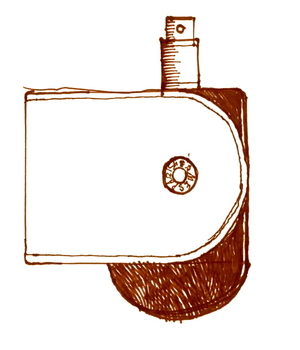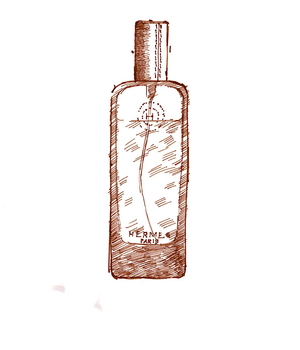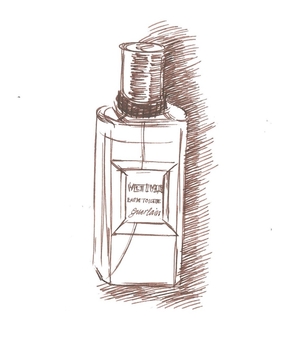Article Archive
Hermès
Voyage d’Hermès parfum
9 May, 2015
 I wouldn’t normally suggest starting your day with a gin and tonic, but that’s exactly what the ‘pure perfume’ version of Voyage d’Hermès smells like when first you spray it on. It’s not really gin and tonic, of course, but it does share two important ingredients: alcohol (which doesn’t in itself smell of anything) and juniper, which adds its bracing, slightly bitter fragrance to both gin and Voyage d’Hermès parfum.
I wouldn’t normally suggest starting your day with a gin and tonic, but that’s exactly what the ‘pure perfume’ version of Voyage d’Hermès smells like when first you spray it on. It’s not really gin and tonic, of course, but it does share two important ingredients: alcohol (which doesn’t in itself smell of anything) and juniper, which adds its bracing, slightly bitter fragrance to both gin and Voyage d’Hermès parfum.
So why not simply spritz yourself with a glass of Gordon’s? It would certainly be cheaper, but if you smell it again after a few minutes you’ll notice that Voyage d’Hermès parfum has more to it than gin. In fact it develops into a very pleasant, slightly spicy-smelling scent, with hints of coriander and pepper and a warm, comforting woodiness underneath.
Launched in 2012, this is in-house perfumer Jean-Claude Ellena’s second take on the original Voyage from 2010, which (backed by a serious advertising budget) went on to become a big seller for the brand. While the original version is a relatively insubstantial eau de toilette – that is, the liquid in the bottle contains around 10 per cent actual perfume, diluted in odourless alcohol – this revised version is labelled as ‘parfum’, or ‘pure perfume’.
But is it? In industry jargon, to call something a ‘parfum’ generally indicates a concentration of around 40 per cent, with a punch – and a price-tag – to match. Yet Voyage d’Hermès parfum costs only around £10 more than the earlier eau-de-toilette, which seems odd. (For comparison purposes, a 50ml bottle of Chanel No5 eau-de-toilette costs about £55, while a mere 30ml of the parfum would set you back £220.) Nor does Voyage d’Hermès parfum last as long as you’d hope a ‘true’ perfume would; in fact it doesn’t even last as long as other Hermès eau-de-toilettes such as Equipage or Bel Ami, which can see you through the day.
So what’s going on? Like other online reviewers I suspect that what we have here is actually what’s known as an eau de parfum, with a concentration of between 15 and 20 per cent, which has been inadvertently mislabelled as a parfum. That’s a shame, as the world of perfume is mystifying enough without muddling up its terminology. Maybe Hermès can explain.
That gripe aside, Voyage d’Hermès parfum is an attractive, easy-to-wear fragrance, and like its predecessor it comes in a nifty bottle (in charcoal grey rather than the earlier version’s clear glass) that swivels within a protective metal case. OK, it’s a bit of a gimmick, but it’s been nicely done given the cost constraints of a mass-produced scent, and as a perfume it’s a safe choice for anyone who isn’t, perhaps, too confident about wearing anything too offbeat or eccentric. Or who simply enjoys the occasional G&T.
Hermès
Vétiver Tonka
18 August, 2014
 Like several other major perfume and fashion brands, Hermès has, in recent years, organised its range of perfumes into a number of different groups. I’m guessing that this is partly to help them refine their message for different segments of the market, but I also wonder whether it has something to do with their in-house perfumer, Jean-Claude Ellena, trying to bring order to a rather disparate collection of scents, in the way that a newly appointed curator might attempt to impose order on a rather muddled art collection.
Like several other major perfume and fashion brands, Hermès has, in recent years, organised its range of perfumes into a number of different groups. I’m guessing that this is partly to help them refine their message for different segments of the market, but I also wonder whether it has something to do with their in-house perfumer, Jean-Claude Ellena, trying to bring order to a rather disparate collection of scents, in the way that a newly appointed curator might attempt to impose order on a rather muddled art collection.
Whether intentionally or not, the groups have been divided in a way that reflects the gradual shift away from gendered to genderless scents, with most of the pre-Ellena perfumes being assigned, in the old-fashioned way, to either women or men (men getting Bel Ami, Equipage and Terre d’Hermès). By contrast most of the more recent scents are categorised by type, not gender, and described as ‘for sharing’ – currently five in Les Colognes collection, four in Les Jardins and eleven in the much more expensive Hermessences range, leaving Eau d’Hermès and Voyage d’Hermès standing on their own.
I’m guessing that the mass-market scents – Voyage and Terre d’Hermès – bring in most of the cash, but what seems to interest Hermès most (and, by extension, Jean-Claude Ellena) are the Hermessences: there are already more of them than there are in any other range, and they’re the only fragrances for which the company does its own in-house PR. They’re also almost twice the price of other Hermès scents: £161 for a 100ml eau-de-toilette as opposed to £73-£80 for a 100ml eau-de-toilette from any of the other groups.
Given how much they cost, you’d expect the Hermessences to be more unusual and have more staying-power than Hermès’ other perfumes, and at least in the case of Vétiver Tonka, that seems to be true. One often-repeated criticism of Jean-Claude Ellena is that the perfumes he creates tend towards the light and evanescent – delicate compositions that disappear all too quickly on the skin. Some people might regard that as a good thing, but as a value-for-money Yorkshireman I want to get some bang for my buck.
Vétiver Tonka certainly lasts, so that’s a good start. It’s also unusual, which for me is another plus – so many perfumes smell almost identical these days. But unusual doesn’t always mean attractive, or even wearable – just smell the amazing Bulgari Black, which is a brilliant scent, but also almost unwearable, at least outside a nightclub. Vétiver Tonka certainly isn’t in that league, but nor does it fit into an easily recognisable ‘normal’ category of scents.
Vetiver, of course, is a classic ingredient of many perfumes aimed at men: extracted from the roots of a tropical grass, it smells earthy and dry, but also fresh; it has the added advantage of being extremely long-lasting, and it can enhance the longevity of other ingredients too. The vetiver that Jean-Claude Ellena has used here, though, is a smoother, less rough-edged extract, which makes the perfume smell perhaps a little more feminine than I’d normally expect.
Tonka – the perfume ingredient, not the toy company – comes from the beans of the cumaru tree, Dipteryx odorata, which grows in Central America and, like laburnum and wisteria, belongs in the pea family. These beans yield coumarin, a chemical that was often used as a cheaper substitute for vanilla; coumarin also smells a bit like cinnamon, almonds or cloves, all of which I get traces of in Vétiver Tonka.
In many ways this is a perfume that does what it says on the tin, for if you can imagine the earthy smell of vetiver mixed with the foody smell of tonka (which many people find slightly chocolatey, probably because of its association with chocolate), then that’s pretty much how Vétiver Tonka smells. The vetiver helps it last all day, but what I mostly smell is the tonka, doubtless blended with many other things – there’s a gentle nuttiness, a bit like rum or sherry, or even a kitchen in the middle of baking day.
When I asked my mum what she thought of it she said, ‘It’s a very nice smell, but it doesn’t really smell like a perfume,’ and I think that pretty much sums it up. Not something you’d necessarily want to adopt as a signature scent, but a quality perfume to try if you fancy smelling a bit out of the ordinary. It also comes in a very nice Hermès box (with a rather cheap-looking cloth bag inside), and the clear-glass bottle – cleverly suffused with pale green – is satisfyingly chunky, with a stitched-leather cap, though whether all that makes it £161 I’m still not sure.
Guerlain
Vetiver
27 April, 2014
 If I had to choose a single perfume from all my favourites, then Guerlain’s Vetiver would be a strong contender. I’m not, I have to admit, entirely sure why, since it’s not the most mysterious or unusual scent I know, but there’s something about its combination of zest and earthiness that’s sexy, tough, and powerfully alluring.
If I had to choose a single perfume from all my favourites, then Guerlain’s Vetiver would be a strong contender. I’m not, I have to admit, entirely sure why, since it’s not the most mysterious or unusual scent I know, but there’s something about its combination of zest and earthiness that’s sexy, tough, and powerfully alluring.
Created by Jean-Paul Guerlain and launched in 1961, Vetiver is, for many people, the ultimate masculine fragrance. Maybe it’s something to do with the way that, when you first spray it on, you get an instant hit of cirtusy cologne mixed in with a whiff of tobacco smoke – like taking a hit from a good cigarette, back in the days when smoking was still thought of as sexy and cool.
But the great thing about Vetiver is that it lasts – and lasts, and lasts, keeping that combination going for longer than might seem possible, largely thanks to the appealingly bitter fresh-earth smell of vetiver. One of the greatest of all natural raw ingredients, vetiver (Vetiveria zizanioides) is a tropical grass that grows wild in southern India, Sri Lanka and Indonesia, but is widely cultivated for perfumery, especially in Haiti and Réunion.
Vetiver oil is steam-distilled from its tough, fibrous roots, which can withstand long periods of both drought and flooding – a bit like the dreaded couch grass that is the bane of British gardeners’ lives. Apart from its extraordinary aroma and staying-power, vetiver oil also has the added advantage of ‘fixing’ other scents and making them last longer too.
Vetiver may be a superb perfume ingredient, but of course it’s only that – an ingredient – and while it plays the leading role in Guerlain’s Vetiver, it’s far from the only component of the scent. For anyone who enjoys olfactory guessing games, see if you can smell some of the others. Among them are things that are more often associated with cookery – coriander, pepper, nutmeg and possibly a touch of chilli extract – which add some extra spice, as well as woody cedar oil. The zesty citrus freshness that you first smell comes from a combination of things like mandarin, lemon, bergamot (from the peel of bergamot oranges) and neroli (from the flowers of Seville orange trees).
Over the years the original recipe is supposed – like so many other supposedly classic perfumes – to have been mucked about with, and the current incarnation is said, by some perfume obsessives, to be not a patch on the original. That’s a shame if it’s true, but short of Guerlain reintroducing the original version (which it probably couldn’t anyway because the regulations governing the use of fragrance ingredients are so much tighter now than they were in the past), we’re stuck with what we have. And what we have, to my nose, is still pretty amazing.
Vetiver is one of those masculine scents that smells so hot I’ve heard of people being followed down the street by total strangers, unable to tear themselves away and desperate to discover what perfume the object of their attention is wearing. Forget all about the so-called Lynx Effect, which has more in common with the Neutron Bomb Effect: Vetiver is the real thing.